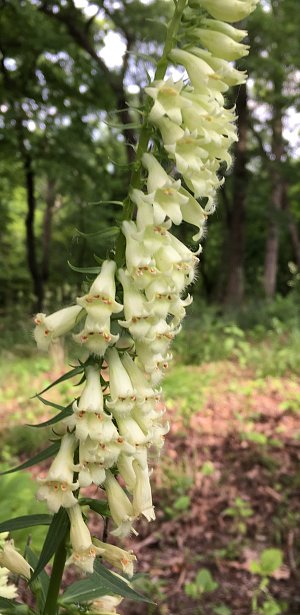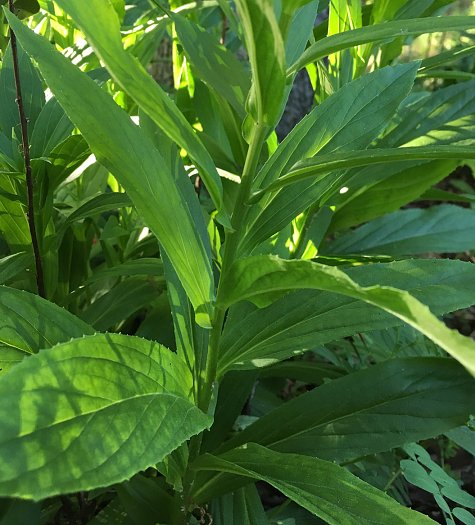 ½–1¼" across; they are lanceolate-oblong to oblanceolate-oblong in
shape and their margins
have small widely-spaced teeth. The leaf surface is medium to dark
green and usually glabrous, although fine hairs may occur along the
veins of the leaf underside. Leaf tips are acute. Leaf venation is
pinnate with a central vein and long outwardly curved lateral veins.
The central stem terminates in a spike-like raceme of flowers about
½–1½' long; each raceme has 15-50 flowers that are arranged largely
along one side. Each flower is about ¾" long, consisting of a pale
yellow or cream-colored corolla that has a swollen tubular shape, a
medium to dark green calyx with 5 recurved teeth, 4 stamens (2 shorter
& 2 longer), and an ovary with a long style. The corolla is
slightly compressed vertically and it is widest toward the
outer-middle. The mouth of the corolla is surrounded by a pair of upper
lobes, 2 lateral lobes, and a slightly larger lower lobe. These lobes
are more or less deltate (triangular) in shape, moderately small in
size, and spread away from the mouth; they are often white-hairy to a
greater or less degree. On some flowers, the lower lobe may be divided
into 2 smaller lower lobes. The corolla interior is either spotless or
brown-spotted. The anthers are light brown to brown. The pedicels of
the flowers are very short and somewhat stout. Solitary leafy bracts up
to 1¼" long occur underneath the flowers; they are
linear-lanceolate in shape. The blooming period occurs from late
spring to mid-summer for about 3 weeks. The flowers may have a sweet
fragrance. Afterwards, the flowers are replaced by ovoid seed capsules.
These seed capsules are light green while they are immature, but they
become dark brown and larger in size at maturity. The capsules
eventually split open to release their seeds. The root system consists
of a taproot. This plant reproduces by reseeding itself.
½–1¼" across; they are lanceolate-oblong to oblanceolate-oblong in
shape and their margins
have small widely-spaced teeth. The leaf surface is medium to dark
green and usually glabrous, although fine hairs may occur along the
veins of the leaf underside. Leaf tips are acute. Leaf venation is
pinnate with a central vein and long outwardly curved lateral veins.
The central stem terminates in a spike-like raceme of flowers about
½–1½' long; each raceme has 15-50 flowers that are arranged largely
along one side. Each flower is about ¾" long, consisting of a pale
yellow or cream-colored corolla that has a swollen tubular shape, a
medium to dark green calyx with 5 recurved teeth, 4 stamens (2 shorter
& 2 longer), and an ovary with a long style. The corolla is
slightly compressed vertically and it is widest toward the
outer-middle. The mouth of the corolla is surrounded by a pair of upper
lobes, 2 lateral lobes, and a slightly larger lower lobe. These lobes
are more or less deltate (triangular) in shape, moderately small in
size, and spread away from the mouth; they are often white-hairy to a
greater or less degree. On some flowers, the lower lobe may be divided
into 2 smaller lower lobes. The corolla interior is either spotless or
brown-spotted. The anthers are light brown to brown. The pedicels of
the flowers are very short and somewhat stout. Solitary leafy bracts up
to 1¼" long occur underneath the flowers; they are
linear-lanceolate in shape. The blooming period occurs from late
spring to mid-summer for about 3 weeks. The flowers may have a sweet
fragrance. Afterwards, the flowers are replaced by ovoid seed capsules.
These seed capsules are light green while they are immature, but they
become dark brown and larger in size at maturity. The capsules
eventually split open to release their seeds. The root system consists
of a taproot. This plant reproduces by reseeding itself.Cultivation: The preference is partial sun or light shade, more or less mesic conditions, and soil containing loam, clay-loam, or humus. During the first year, this plant may form little more than a rosette of leaves, but it will bolt and flower reliably thereafter if it receives enough light. It is supposed to be cold-hardy to about 5° Fahrenheit (-15° Celsius).
Range & Habitat: Straw Foxglove (Digitalis lutea) has naturalized in Peoria County, Illinois (see Distribution Map) at or near the top of a wooded ravine in a semi-shaded area. It has persisted at this site for several years or even decades. This non-native wildflower has rarely naturalized in Illinois and it is uncommonly cultivated in gardens. Straw Foxglove is native to continental Europe and possibly North Africa. In addition to Illinois, this wildflower has naturalized in several states of northeastern and Midwestern USA; also in Quebec, Canada. Typical habitats of such naturalized populations include weedy meadows, overgrown thickets, disturbed open woodlands, and the upper slopes of wooded ravines. At the present time, Straw Foxglove is not considered invasive nor particularly aggressive.
Faunal Associations: The flowers are cross-pollinated by long-tongued bumblebees. Both nectar and pollen are available as floral rewards (Percival & Morgan, 1965). A polyphagous aphid, Aphis fabae (Black Bean Aphid), sucks sap from this plant (Wilkaniec & Piekarska-Boniecka, 2008). Because the foliage of this plant is bitter-tasting and toxic from cardiac glycosides, mammalian herbivores normally shun this plant as a food source.
Photographic Location: At or near the top of a shaded ravine near Peoria, Illinois. The photographs of this plant were taken by Layne Brown (Copyright © 2017).

Comments: Straw Foxglove (Digitalis lutea) is one of a small number of European Digitalis spp. (Foxgloves) that are cultivated in gardens. This group of plants has been cultivated in Europe for a long time as medicinal herbs because they contain compounds (cardiac glycosides) that affect the functioning of the heart. Even today, the drug 'Digitalis' is prescribed by cardiologists for heart-related problems. Because of the potentially dangerous side effects of these compounds, these plants should not be used for self-medication. Straw Foxglove can be distinguished from other Foxglove species by the smaller size of its flowers (typically about ¾" in length), corollas that are pale yellow or cream-colored throughout (except sometimes for brown spots within the interior), and foliage that is hairless or nearly so. Straw Foxglove superficially resembles one of the native Penstemon spp. (Penstemons), but none of the latter in Illinois have yellowish flowers nor do they have spike-like racemes where the flowers congregate along one side. Some botanists have reassigned the Digitalis genus to the Plantain family (Plantaginaceae) on the grounds that the Figwort family (Scrophulariaceae) is more genetically diverse than originally expected. Another common name of Digitalis lutea is Yellow Foxglove.